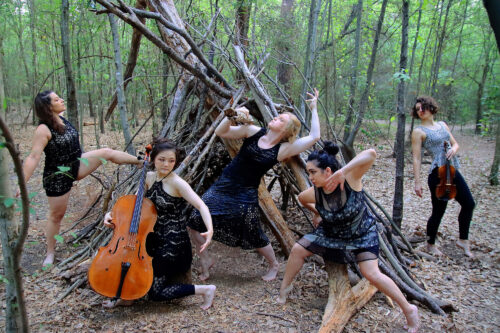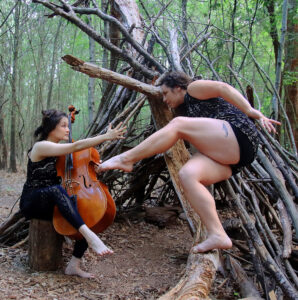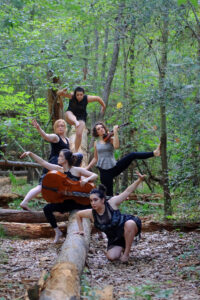Collaboration Branches Out in PDC Works’ Take Root

Photo by Pin Lim / Forest Photography
I had the incredible fortune to have danced for Sophia Torres, artistic director of PDC Works, when the company still went by Psophonia. The work pushed me – emotionally and physically – to adopt different perspectives, including that of a tree in Phantasia 2007. We moved microscopically, miming the growth and intertwining of tree roots and branches. Over the last couple of years, Torres has revisited these representations through a richly-layered collaboration with Rob Smith, professor of composition at the University of Houston and director of the Moores School of Music AURA ensemble. How do ideas take root, then branch out? I connected with Torres and Smith to learn more about the nature of their collaboration and how art can promote awareness about our relationships with the environment.
Take Root marks the third large-scale collaboration between Torres and Smith and the second that focuses on the environment. (In Colony (2019), they homed in on the honeybee crisis.) Their work exemplifies the interdependence they seek to convey to audiences regarding our relationships with nature. As Smith explains, their process involves each contributor taking the lead over certain pieces of the project. For Take Root, they first developed a storyline together. Torres then set choreography and Smith composed music to match the movement, resulting in a thirty-minute incarnation presented in October 2021. Moving forward, the musical composition has at times taken the lead. Importantly, Smith notes, all of the artists (the cast of nine dancers and musicians perform live together), “equally share the space, as the musicians are involved in the choreography.” Additionally, their ongoing collaboration has allowed the pair to “have built greater trust in one another and a willingness to take more risks,” Torres says. Perhaps the awareness of our environment brought by Take Root could similarly deepen our willingness to trust our trees and take more risks on their behalf.

Photo by Pin Lim / Forest Photography
Torres and Smith provide the guiding vision of Take Root; however, collaboration extends into all facets of the production. Set designer Keith Epperson has created a sculpture that will hang in the lobby of the performance space, and talks about trees in the urban landscape precede the Thursday and Friday performances. Conservation experts Trent Rondot and Marissa G. Llosa from the Houston Parks Board will speak on Thursday and Senior Naturalist Patti Bonnin from the Houston Arboretum & Nature Center on Friday. In the tradition of site-specific work that emerged from postmodern dance of the 1960s and 1970s (also the moment that many Americans first paid attention to environmental concerns, spurred by the publication of Rachel Carson’s Silent Spring in 1962), Take Root also considers the space as an equal partner in the project. Audiences will have the opportunity to watch the piece from different viewpoints in the lobby of the Gerald D. Hines College of Architecture and Design building at the University of Houston. During the performance, audience members may walk around, including changing levels to look into the lobby. According to Torres, the open space has led her to contemplate the choreography from a 360 degree perspective.
When asked how art is uniquely suited to invite people to look closely at their relationships with nature, both Torres and Smith commented on connection. Smith connects emotion with action, saying that “there is a strong emotional component that initially draws one in,” which will ideally, “create a dialogue and understanding that will ultimately benefit society.” Torres’s connection stems from curiosity about nature, rather than people’s reactions to the work. She asks, “What’s buried underground? It’s lost treasure. Isn’t that interesting enough? Isn’t that worthy of dance, music, art? Trees are the reason we live – literally We are bound to them. We’ve just gone blind to it all; we just thought it would always be there. And what if it’s not? What if we say nothing, do nothing?”

Photo by Pin Lim / Forest Photography
Although many of us would prefer to dispense with the pandemic as we eye a “new normal,” we do ourselves a disservice when we ignore the growth that the period has nurtured. As Torres notes, the lockdown period led her to the realization that “I took for granted the peace and openness nature offers. Trees and my connection to them pre-COVID lay on the fringes of my vision and thinking.” Both Torres and Smith see opportunity in our experiences of the past two years. As Smith shares, “I hope we encourage the audience to slow down, dig in, and listen; there are lessons we can learn from nature.” We see the tree but not necessarily the roots; how may we shift our thinking towards those roots and their impact on our daily lives? Take Root offers one step on the journey to reconnect, to rejuvenate our interdependence on nature.
Audiences should branch out to the lobby of University of Houston’s Gerald D. Hines College of Architecture and Design building to absorb Take Root on Thursday August 25, Friday August 26, or Saturday August 27. The free, family-friendly, forty-five minute program begins at 6:30pm on Thursday and Friday and 7:30pm on Saturday (take note of the different start times); pre-concert talks on Thursday and Friday will begin at 6pm. Performers will be: Nina Bledsoe-Knight (viola), Roberto de Guzman (clarinet), Bing Wei (cello), and dancers Lindsay Cortner, Keeley Dunnam, Melissa Juneau, Mia Pham, Tory Pierce, and Arielle Tesia Rojas. Tickets are not needed. For more information on Take Root and other collaborations by Torres and Smith, visit PDC Works.
PDC Works is funded in part by the Cynthia Wood Mitchell Center for the Arts and the New Music USA Organizational Development Fund.



One of the great gifts of Sophia Torres’ work is how it expresses deep feeling and meaning, while being accessible and engaging to those new to modern dance.
The musician’s involvement in the dance as well as the music adds another layer of interest and interconnection that strengthens both the dance and the music.